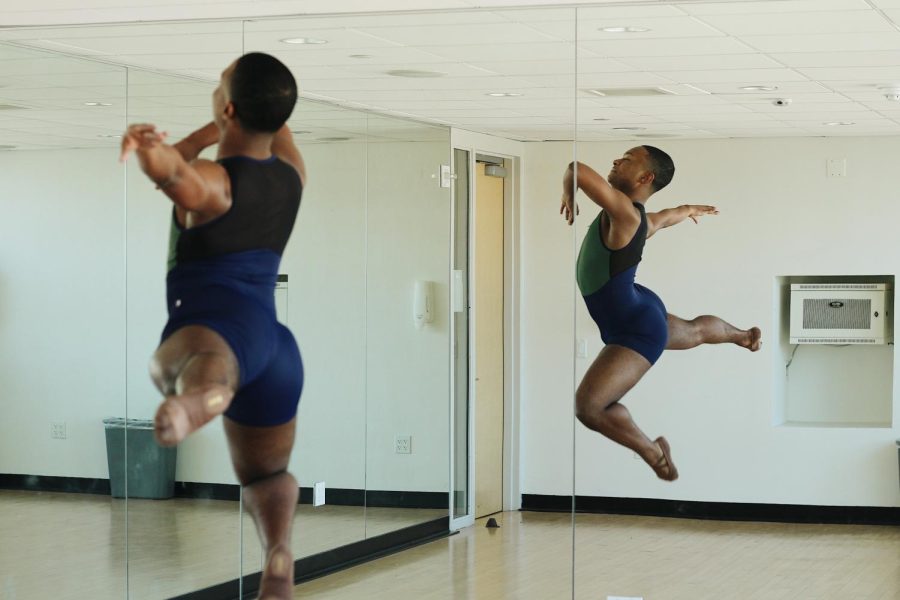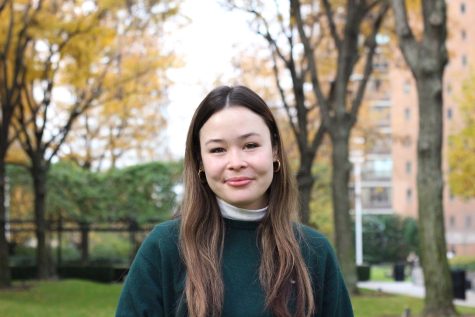Balancing Act: A Look Into Fordham Dancers’ Well-Being Amid Pandemic
Coordination between Fordham and Ailey is precipitating mental health and academic issues among dance majors
Ali-asha Polson, Ailey ’25, practicing a routine. Many dancers have reported increased stress and workload, as well as more trouble balancing academic commitments with dancing.
March 3, 2022
The writer of this article is a dance major in The Ailey Dance School.
Although life during the pandemic has reached its own sense of normalcy, the mental and physical effects of this “new normal” continue to take its toll. This is especially clear in student life.
After almost a year and a half of virtual learning, colleges and universities around the U.S. reopened their doors for the fall 2021 semester. For about half of the Fordham undergraduate population, it was the first time setting foot on campus — for others, since the school closed in March of 2020.
Life as a Fordham dancer has never looked more different.
Dance majors at The Alvin Ailey School, on the other hand, have had very different experiences. Now pushing two years of dancing in masks and in cohorts ranging from six to 17 students in size, life as a Fordham dancer has never looked more different.
Stress and burnout in college students are extremely common, more so in the past couple of years as concerns of falling behind in classes increased when students were forced to remain home.
Fordham has attempted to mitigate these stressors by offering free summer classes and increasing credit allowances. But add multiple majors and minors to rigid dance schedules, and you will only scratch the surface of a current dance major’s life.
With safety and staying open at the forefront of Fordham’s and The Ailey School’s mission for the year, dance majors are also expected to know and abide by two separate institutional protocols: Fordham Forward and Ailey Forward.
Sydney Jones, Fordham College at Lincoln Center (FCLC) ’24 and a student in the Ailey dance program, experienced such stress over the course of the past year.
“I feel as if the pandemic stunted my mental stamina and capacity when it comes to juggling my academic responsibilities and my dance ones as well,” Jones said. “I don’t feel as motivated and determined as I was before the pandemic.”
A majority of an Ailey student’s course load is made up of dance classes, not including the mandatory two academic classes per semester. For Audrey Lipson, FCLC ’22 and a student in the Ailey dance program, the most stressful part of being a student dancer is dealing with injuries.
“I found the correlation between chronic pain and depression to be very unmanageable at times,” she said.
With safety and staying open at the forefront of Fordham’s and The Ailey School’s mission for the year, dance majors are also expected to know and abide by two separate institutional protocols: Fordham Forward and Ailey Forward. Though very similar in structure and easy to follow, minor differences in protocols often leave students searching for answers, receiving mixed information and ultimately stuck in administrative limbo.
For instance, Ailey students are prohibited from using the elevators at the studios, which have been reserved for teachers and staff. Ailey students must also utilize the “HealthCheck” screening app, which is functionally identical to VitalCheck but requires two separate check-ins.
Even before the pandemic, Ailey students were known to have issues registering for classes between institutions. The COVID-19 pandemic has only further destabilized this process. The Ailey School’s registration process, paired with Fordham’s own limited course offerings, has caused increased scheduling inflexibility.
Despite the stress and frustration, the dance majors do their best to cope.
Block scheduling of dance classes, while indeed effective in minimizing student exposure during travel, has greatly limited available time for academics. Thus, limited course options have impacted dancers planning on double majoring or minoring, as certain classes are only offered once a year.
Gabriella Lopez, FCLC ’23 and a student in the Ailey program who is currently a student on medical leave, said, “In order to graduate on time, I needed to register for my dance classes, even though I cannot physically participate. I am trying to utilize this time to complete my second major in Sociology, but I used up credits for dance classes that I could not be involved in.”
Despite the stress and frustration, the dance majors do their best to cope. Lipson also mentioned that “knowing and advocating for my physical, psychological and social limits” helps her and others “try to get the most out of what (they) have.”
Dancers remain hopeful for the day when they can perform normally again and create a future where dancer mental health and well-being are put first above expectations of traditional perfection.
Many dancers remain frustrated.
Indeed, the stressors and injuries will not heal overnight, but dancers remain hopeful for the day when they can perform normally again and create a future where dancer mental health and well-being are put first above expectations of traditional perfection.










